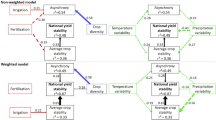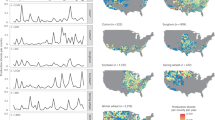Abstract
Multiple breadbasket failure is a risk to global food security. However, there are no global analyses that have quantitatively assessed if global crop production has actually tended towards synchronized failure historically. We show that synchronization in production within major commodities such as maize and soybean has declined in recent decades, leading to increased global stability in production of these crops. In contrast, synchrony between crops has peaked, making global calorie production more unstable. Under the hypothetical event of complete synchronized failure we estimate simultaneous global production losses for rice, wheat, soybean and maize to lie between −17% and −34%. We find that offsetting these losses by reducing variation in production across all growing locations, and raising production ceilings in breadbaskets, are far more effective than strategies focused on reducing variability in breadbaskets alone or closing production gaps in low productive locations. Our findings suggest that maintaining asynchrony in the food system requires a central place in discussions of future food demand under mean climate change, population growth and consumption trends.
This is a preview of subscription content, access via your institution
Access options
Access Nature and 54 other Nature Portfolio journals
Get Nature+, our best-value online-access subscription
$29.99 / 30 days
cancel any time
Subscribe to this journal
Receive 12 digital issues and online access to articles
$119.00 per year
only $9.92 per issue
Buy this article
- Purchase on Springer Link
- Instant access to full article PDF
Prices may be subject to local taxes which are calculated during checkout


Similar content being viewed by others
Data availability
All data are available for download from the cited sources, except for the crop production time series, which are not distributable by the authors. Requests for these production time series data should be made to Deepak Ray (dray@umn.edu).
Code availability
The code used to generate the R46 script can be accessed in the Supplementary Information.
References
Devereaux, S. Famine in the Twentieth Century Working Paper 105 (IDS, 2000); https://www.ids.ac.uk/files/dmfile/wp105.pdf
Lesk, C., Rowhani, P. & Ramankutty, N. Influence of extreme weather disasters on global crop production. Nature 529, 84–87 (2016).
Gilbert, C. L. & Morgan, C. W. Food price volatility. Phil. Trans. R. Soc. B 365, 3023–3034 (2010).
Bailey, R., et al. Extreme Weather and Resilience of the Global Food System (The Global Food Security programme, UK, 2015); https://www.foodsecurity.ac.uk/publications/extreme-weather-resilience-global-food-system.pdf
Battisti, D. S. & Nalyor, R. L. Historical warnings of future food insecurity with unprecedented seasonal heat. Nature 323, 240–244 (2009).
Sen, A. The economics of life and death. Sci. Am. 268, 40–47 (1993).
Laio, F., Ridolfi, L. & D’Odorico, P. The past and future of food stocks. Environ. Res. Lett. 11, 035010 (2016).
Suweis, S., Carr, J. A., Maritan, A., Rinaldo, A. & D’Odorico, P. Resilience and reactivity of global food security. Proc. Natl Acad. Sci. USA 112, 6902–6907 (2015).
Kim, J. J. & Guha-Sapir, D. Famines in Africa: is early warning early enough? Global Health Action 5, 3–5 (2012).
Famine Early Warning System (FEWS, 2017); https://www.fews.net/
Tadesse, G., Algieri, B., Kalkuhl, M. & von Braun, J. Drivers and triggers of international food price spikes and volatility. Food Policy 47, 117–128 (2014).
Myers, S. S. et al. Climate change and global food systems: potential impacts on food security and undernutrition. Annu. Rev. Publ. Health 38, 259–277 (2016).
The State of Food Insecurity in the World (Food and Agriculture Organization, 2010); http://www.fao.org/docrep/013/i1683e/i1683e.pdf
Food System Shock (Lloyds, 2015); https://www.lloyds.com/news-and-risk-insight/risk-reports/library/society-and-security/food-system-shock
von Uexkull, N., Croicu, M., Fjelde, H. & Buhaug, H. Civil conflict sensitivity to growing-season drought. Proc. Natl Acad. Sci. USA 113, 12391–12396 (2016).
Buhaug, H., Benjaminsen, T. A., Sjaastad, E. & Theisen, O. M. Climate variability, food production shocks, and violent conflict in sub-Saharan Africa. Environ. Res. Lett. 10, 125015 (2015).
Schleussner, C. -F., Donges, J. F., Donner, R. V. & Schellnhuber, H. J. Armed-conflict risks enhanced by climate-related disasters in ethnically fractionalized countries. Proc. Natl Acad. Sci. USA 113, 9216–9221 (2016).
Ben-ari, T. & Makowski, D. Decomposing global crop yield variability. Environ. Res. Lett. 9, 114011 (2014).
Ben-Ari, T. & Makowski, D. Analysis of the trade-off between high crop yield and low yield instability at the global scale. Environ. Res. Lett. 11, 104005 (2016).
de Mazancourt, C. et al. Predicting ecosystem stability from community composition and biodiversity. Ecol. Lett. 16, 617–625 (2013).
Wang, S. & Loreau, M. Ecosystem stability in space: alpha, beta and gamma variability. Ecol. Lett. 17, 891–901 (2014).
Cardinale, B. J. et al. Biodiversity loss and its impacton humanity. Nature 486, 59–67 (2012).
Khoury, C. K. et al. Increasing homogeneity in global food supplies and the implications for food security. Proc. Natl Acad. Sci. USA 111, 4001–4006 (2014).
Lipper, L. et al. Climate-smart agriculture for food security. Nat. Clim. Chang e 4, 1068–1072 (2014).
Lin, B. B. Resilience in agriculture through crop diversification: adaptive management for environmental change. Bioscience 61, 183–193 (2011).
Burney, J. A., Naylor, R. L. & Postel, S. L. The case for distributed irrigation as a development priority in sub-Saharan Africa. Proc. Natl Acad. Sci. USA 110, 12513–12517 (2013).
Mueller, N. D. et al. Closing yield gaps through nutrient and water management. Nature 490, 254–257 (2012).
Tester, M. & Langridge, P. Breeding technologies to increase crop production in a changing world. Science 327, 818–822 (2010).
Cohen, J. E. & Xu, M. Random sampling of skewed distributions implies Taylor’s power law of fluctuation scaling. Proc. Natl Acad. Sci. USA 112, 7749–7754 (2015).
Tollenaar, M. & Lee, E. A. Yield potential, yield stability and stress tolerance in maize. Field Crop. Res. 75, 161–169 (2002).
Ramankutty, N. et al. Trends in global agricultural land use: implications for environmental health and food security. Annu. Rev. Plant Biol. 69, 789–815 (2018).
Ray, D. K., Gerber, J. S., MacDonald, G. K. & West, P. C. Climate variation explains a third of global crop yield variability. Nat. Commun. 6, 5989 (2015).
Iizumi, T. & Ramankutty, N. Changes in yield variability of major crops for 1981–2010 explained by climate change. Environ. Res. Lett. 11, 034003 (2010).
Foley, J. A. et al. Solutions for a cultivated planet. Nature 478, 337–342 (2011).
Tilman, D., Balzer, C., Hill, J. & Befort, B. L. Global food demand and the sustainable intensification of agriculture. Proc. Natl Acad. Sci. USA 108, 20260–20264 (2011).
Godfray, H. C. J. et al. Food security: the challenge of feeding 9 billion people. Science 327, 812–818 (2010).
Reaping the Benefits: Science and the Sustainable Intensification of Global Agriculture (The Royal Society, 2009).
Haddad, L. et al. A new global research agenda for food. Nature 540, 30–32 (2016).
Garnett, T. Plating up solutions. Science 353, 1202–1204 (2016).
Battiston, S., Caldarelli, G., May, R. M., Roukny, T. & Stiglitz, J. E. The price of complexity in financial networks. Proc. Natl Acad. Sci. USA 113, 10031–10036 (2016).
Ray, D. K., Ramankutty, N., Mueller, N. D., West, P. C. & Foley, J. A. Recent patterns of crop yield growth and stagnation. Nat. Commun. 3, 1293 (2012).
Sacks, W. J., Deryng, D., Foley, J. A. & Ramankutty, N. Crop planting dates: an analysis of global patterns. Global Ecol. Biogeogr. 19, 607–620 (2010).
Monfreda, C., Ramankutty, N. & Foley, J. A. Farming the planet: 2. Geographic distribution of crop areas, yields, physiological types, and net primary production in the year 2000. Global Biogeochem. Cy. 22, 1–19 (2008).
Willmott, C. J. & Matsuura, K. Terrestrial Air Temperature and Precipitation: 1900–2014 Gridded Monthly Time Series (V 4.01) (2001); http://climate.geog.udel.edu/~climate/html_pages/download.html#P2014
Cassidy, E. S., West, P. C., Gerber, J. S. & Foley, J. A. Redefining agricultural yields: from tonnes to people nourished per hectare. Environ. Res. Lett. 8, 034015 (2013).
R: A Language and Environment for Statistical Computing (R Core Development Team, 2017).
Acknowledgements
We thank D. Ray for sharing the time series crop production data set. N.R. and Z.M. were funded by an NSERC Discovery Grant No. RGPIN-2017–04648 and a grant from Genome Canada/Genome BC.
Author information
Authors and Affiliations
Contributions
Z.M. had the idea and performed the analysis. Z.M. and N.R. designed the research, interpreted the results, and wrote the paper.
Corresponding author
Ethics declarations
Competing interests
The authors declare no competing interests.
Additional information
Publisher’s note: Springer Nature remains neutral with regard to jurisdictional claims in published maps and institutional affiliations.
Supplementary information
Supplementary Information
Supplementary Description of Data and Analysis, Supplementary Figures 1–9 and Supplementary References
Rights and permissions
About this article
Cite this article
Mehrabi, Z., Ramankutty, N. Synchronized failure of global crop production. Nat Ecol Evol 3, 780–786 (2019). https://doi.org/10.1038/s41559-019-0862-x
Received:
Accepted:
Published:
Issue Date:
DOI: https://doi.org/10.1038/s41559-019-0862-x
This article is cited by
-
Research progresses and prospects of multi-sphere compound extremes from the Earth System perspective
Science China Earth Sciences (2024)
-
Increased drought and extreme events over continental United States under high emissions scenario
Scientific Reports (2023)
-
Global droughts connected by linkages between drought hubs
Nature Communications (2023)
-
Likely decline in the number of farms globally by the middle of the century
Nature Sustainability (2023)
-
Global risk assessment of compound hot-dry events in the context of future climate change and socioeconomic factors
npj Climate and Atmospheric Science (2023)



